Unlocking the Diverse Advantages of Virtual Reality
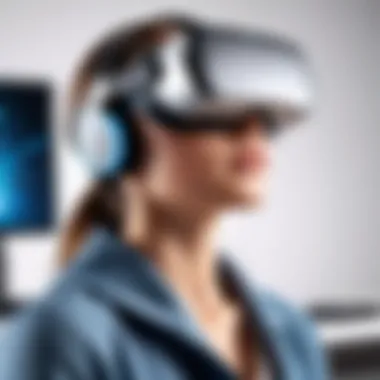
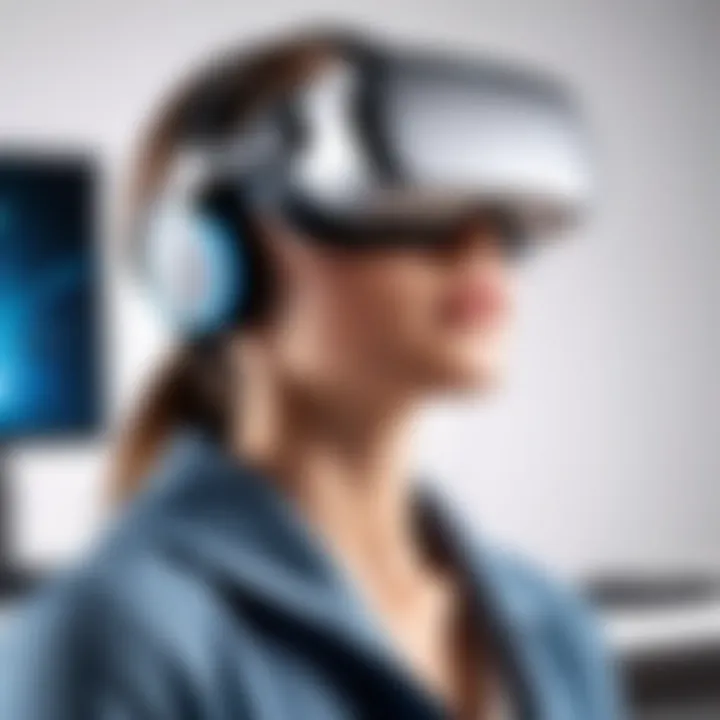
Intro
Virtual reality (VR) has transcended its initial identity as a niche entertainment medium to become a transformative force across numerous sectors. The implications of this technology are profound, influencing areas such as education, healthcare, entertainment, and professional training. This article will delve into these sectors, shedding light on how VR is enhancing engagement, improving outcomes, and reshaping interactions within increasingly digital environments.
As you read further, you will discover a wealth of information about VR's multifaceted benefits. The content aims to provide a structured exploration, making it easy to navigate the complexities of this rapidly evolving field.
Understanding the Benefits of Virtual Reality
Impact on Education
Virtual reality is revolutionizing education. By simulating real-world situations, it allows students to learn and practice in ways traditional classrooms cannot provide. For example, medical students can perform virtual surgeries, gaining experience without the risks associated with live procedures. This immersive experience not only captivates attention but also enhances retention of knowledge. Educators are now able to tailor experiences based on individual needs, offering personalized learning environments that cater to varied learning styles.
Role in Healthcare
In healthcare, VR's applications range from patient treatment to medical training. It is used in pain management, where patients can engage with calming virtual environments that distract from discomfort. Furthermore, hospitals utilize VR for staff training, enabling them to rehearse complex procedures in a risk-free setting. This technology is proving invaluable in mental health treatments as well, providing exposure therapy in controlled, safe environments.
Enhancements in Entertainment
The entertainment industry has seen significant transformation due to virtual reality. Games like Beat Saber and Half-Life: Alyx have set benchmarks with immersive storytelling and interactivity. VR creates a new level of engagement, drawing players into fully realized worlds. This engagement goes beyond gaming and extends to virtual concerts and experiences that allow users to feel present without physical constraints.
Training and Professional Development
In professional settings, VR serves as a powerful tool for training programs. Industries like aviation, construction, and military use VR simulations for high-stakes training, allowing individuals to practice skills without actual risk. These simulations provide realistic scenarios that prepare employees for potential challenges they would face in the field, thus enhancing overall performance and safety.
Practical Applications and Future Implications
As VR technology continues to evolve, its implications are broadening. Companies are investing heavily in VR capabilities, not just for individual sectors but for cross-sector applications as well. This expanding relevance signals a future where VR may become mainstream for communication and interaction, driving further innovations.
"The future of virtual reality will integrate with our daily lives, transforming how we interact, learn, and work."
By understanding these multifaceted benefits, stakeholders across various industries can harness the full potential of virtual reality. The following sections will provide deeper insights into specific applications and how VR reshapes contemporary discussions surrounding technology.
Preface to Virtual Reality
Virtual Reality (VR) has emerged as a significant technological advancement with broad applications that enhance various fields. Understanding VR is crucial as it shapes how we interact with content, learn, and engage socially. In this article, we delve into the multi-layered advantages of virtual reality, exploring its intricate relationship with education, healthcare, entertainment, and corporate training.
Definition and Overview
Virtual reality refers to a computer-generated environment that enables users to experience immersive digital worlds. Unlike traditional media that present content passively, VR allows users to interact with their surroundings. The technology typically employs headsets, sensors, and sometimes handheld controllers to simulate real-life experiences.
By creating a 3D environment, VR engages multiple senses, such as sight, sound, and even touch. This level of immersion leads to improved retention of information and deeper emotional engagement. When considering its definition, it is also vital to understand its components, including rendering techniques, tracking systems, and user interfaces that enhance usability and accessibility.
Historical Context
The evolution of virtual reality traces back to the mid-20th century when conceptual frameworks began forming around immersive environments. Early works include Morton Heilig's Sensorama in the 1960s, a device that offered users a multi-sensory experience, but did not fully realize the concept of VR. The term 'virtual reality' was coined by Jaron Lanier in the 1980s, who offered a glimpse into how computers could create new worlds.
By the 1990s, companies like Sega and Atari attempted to create consumer-grade VR systems, yet these endeavors were limited by technological constraints. With advancements in computing power, graphics rendering, and head-tracking sensors, the turn of the 21st century saw a resurgence in VR interest. Today, VR is not just a concept; it plays an integral role across various sectors.
This historical perspective demonstrates the technological quest to redefine how humans experience digital content and make tangible interactions within virtual spaces. With VR's ongoing development, its potential applications continue to broaden, promising even greater transformation in how individuals connect and engage with the digital realm.
Benefits in Education
The role of virtual reality (VR) in education is becoming increasingly important as technology advances. VR provides unique opportunities to enhance learning experiences and expand remote learning capabilities. In a world where education must adapt to diverse needs and ever-changing environments, integrating VR can significantly improve educational outcomes. Educators are discovering how VR can engage students, making learning more interactive and immersive.
Enhanced Learning Experiences
Virtual reality offers a platform for enhanced learning experiences that traditional methods struggle to achieve. With VR, students can visualize complex concepts in a tangible way. For example, a student studying anatomy can explore the human body in 3D, providing a deeper understanding of how organs function together. Furthermore, immersive environments allow learners to experiment and practice skills without real-world consequences. This hands-on approach is especially valuable in fields like science and engineering.
Employers are increasingly seeking candidates with practical experience. VR helps bridge the gap between theory and practice by enabling students to engage in simulations that replicate real-world scenarios. This method of experiential learning not only enhances critical thinking skills but also fosters creativity and problem-solving abilities.
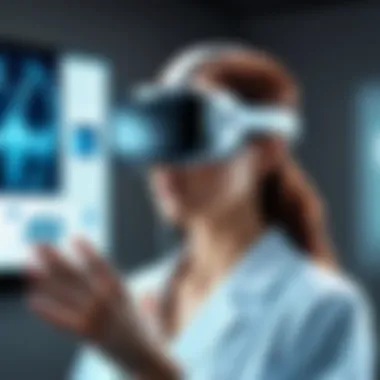

"Virtual reality is not just a tool; it's a gateway to comprehensive understanding."
Remote Learning Capabilities
The COVID-19 pandemic highlighted the importance of remote learning, and VR has emerged as a powerful solution. Virtual reality transcends geographical barriers, allowing students to participate in classes from anywhere. This capability is particularly beneficial for learners in rural or underserved areas who might lack access to quality education.
VR platforms facilitate shared experiences among students, creating a sense of presence and collaboration. For instance, a student can join peers in a virtual classroom, interact with educational content, and even collaborate on group projects. This level of engagement is often missing from traditional online learning environments.
Moreover, VR can adapt to different learning styles. Visual learners benefit from 3D simulations, while auditory learners can take advantage of narrated experiences. This flexible approach addresses individual learning needs, aiding in student retention and understanding of material. As educational institutions continue to embrace digital transformation, the integration of VR in remote learning will likely grow, alleviating some of the limitations of distance education.
Healthcare Applications
The application of virtual reality in healthcare is a rapidly evolving field that holds immense potential for improving patient outcomes and enhancing medical training. The integration of VR technology introduces unique methodologies for both therapeutic practices and education within the medical sphere. The significance of this topic cannot be overstated, especially given its implications for improving both patient care and healthcare practices.
Therapeutic Uses
Virtual reality has gained recognition as a promising tool in various therapeutic scenarios. Its application extends across multiple domains, including pain management, rehabilitation, and psychotherapy.
- Pain Management: VR offers a distraction from pain during medical procedures and treatments. Patients can engage in immersive environments that occupy their attention, potentially reducing their perceived pain levels.
- Rehabilitation: For individuals recovering from injury or surgery, VR provides interactive exercises that are both engaging and beneficial. Clinicians can tailor rehabilitation programs that simulate real-life scenarios, enabling patients to practice movements and skills in a safe environment.
- Psychotherapy: Exposure therapy has embraced VR to help individuals confront fears and anxieties in controlled settings. For instance, patients with phobias can gradually interact with their fears within a virtual space, working towards desensitization.
The effectiveness of these therapeutic uses is supported by various studies. Incorporating VR into treatment regimens can enhance motivation among patients and can be especially beneficial in pediatrics, where traditional methods may not engage younger audiences.
Training for Medical Professionals
In addition to therapeutic applications, VR is markedly advantageous in the training of medical professionals. The ability to simulate complex procedures without the risks associated with real-life surgeries is a game changer for medical education.
- Surgical Training: Surgeons can practice intricate surgical techniques in a risk-free environment. This hands-on experience allows them to hone their skills repeatedly, leading to higher success rates in actual operations.
- Emergency Response: Healthcare workers can undergo simulated emergency scenarios that enhance their response skills. Situations can be made realistic and challenging, pushing trainees to operate under high pressure while demonstrating the necessary protocols.
- Team Training: VR enables team-based training for medical professionals, fostering communication and coordination among various healthcare providers. By immersing teams in simulated clinical environments, they can practice workflows and improve collaboration before engaging in real-life situations.
Transformative Power of VR in Entertainment
Virtual reality is revolutionizing the entertainment industry. Its capacity to transport users into vivid virtual worlds creates a unique experience that traditional media cannot match. This transformative power lies in the ability to engage audiences on multiple levels. Immersion in a digital universe encourages deeper emotional connections to content, transcending conventional storytelling and gaming methods.
Immersive Storytelling
Storytelling in virtual reality has moved beyond simple narratives. VR enables developers to construct environments where users interact with the story in real-time. This interactivity adds a layer of depth. People are not just spectators; they become characters within the narrative. A powerful example is the experience created by games like "Half-Life: Alyx", where users can physically explore the world, solve puzzles, and interact with the environment.
Benefits of immersive storytelling can be substantial:
- Personal Engagement: Users connect emotionally to the characters and scenarios.
- Active Participation: Users take part in shaping the plot, leading to distinct experiences for each individual.
- Enhanced Memory Retention: Interactive elements help users remember details better than passive forms of entertainment.
However, there are challenges. Developers must ensure that the story remains coherent despite the freedom given to users. Maintaining an engaging narrative while allowing for exploration is essential.
Interactive Gaming Experiences
In gaming, virtual reality offers more than just visual upgrades. It transforms gameplay mechanics, promoting active involvement. Players can move, act, and respond physically, which reflects a more natural gaming experience. The rise of consoles like the Oculus Quest has enabled these interactive features, making it accessible for a wider audience.
Key advantages of interactive gaming using VR include:
- Physical Activity: Many VR games require movement, encouraging users to be more active.
- Social Interaction: Multiplayer modes allow players to connect and collaborate in virtual spaces, enhancing the social aspect of gaming.
- Innovative Gameplay Mechanics: New mechanics, like using hand gestures or voice commands, are unique to VR, creating more engaging experiences.
Despite the advancements, game developers face challenges. Ensuring player comfort and minimizing motion sickness are critical issues. Titles need to balance realism with enjoyable gameplay to keep users engaged without discomfort.
"The future of entertainment lies in user-centric experiences, and virtual reality paves the way for that evolution."
As the VR industry grows, understanding its potential to shape storytelling and interactive gaming is vital. For IT professionals and cybersecurity experts, this innovation raises questions regarding security measures and data privacy. Ensuring the technology's potential does not compromise user privacy is an essential focus area as VR continues to evolve.
Corporate Training and Development
In the fast-evolving landscape of corporations, training and development have garnered increased attention. Virtual reality is emerging as a powerful tool in this realm. It provides innovative solutions that can augment traditional training methodologies. The significance of VR in corporate training addresses the need for more engaging and practical educational experiences.
Corporations face several challenges when training employees. Conventional methods often result in varying levels of employee engagement and retention. Virtual reality offers immersive environments that simulate real-world scenarios. These experiences can drastically improve knowledge retention and application. Notably, VR enables employees to experiment in a risk-free setting.


Realistic Simulations
One of the primary advantages of VR in corporate training is its capacity to deliver realistic simulations. Traditional training methods, such as lectures or e-learning modules, can sometimes fail to capture the complexities of real-life situations. With VR, employees can rehearse critical tasks or engage in problem-solving scenarios that closely mimic their work environment. For example, a banking employee can practice handling difficult customer interactions in a virtual setting, where mistakes can be made without real-world implications.
Moreover, involving employees in realistic simulations can enhance their ability to assimilate information rapidly. The immersive nature of VR aids in visualizing concepts and processes that are abstract when explained in typical classroom settings. Companies like Walmart have already implemented VR training for their staff to familiarize them with various store scenarios, thus improving the overall customer service experience.
Cost-Effectiveness in Training Programs
Another compelling aspect of VR in corporate training is its potential cost-effectiveness. While initial investment in VR technology can be significant, the long-term benefits often outweigh these costs. VR training allows companies to save on travel expenses, venue rentals, and materials associated with traditional training programs.
Additionally, by utilizing VR for training, employees can train on their schedules, reducing downtime and increasing productivity. Companies can foster a culture of continuous learning without the logistical burdens of organizing in-person sessions.
- Reduced onboarding time: New employees can reach productivity faster through VR training.
- Scalable training: Virtual environments can be replicated for multiple users simultaneously, maximizing resource usage.
- Lower error rates: Employees who train in simulated environments tend to make fewer mistakes in actual work scenarios.
"Using VR in corporate training can transform how skills are developed, reducing costs while enhancing effectiveness."
Social Engagement in Virtual Environments
As society becomes increasingly digital, the importance of social engagement within virtual environments cannot be overstated. Virtual reality (VR) platforms offer unique opportunities for social interaction that can transcend geographic and physical limitations. By providing immersive experiences where users can connect, collaborate, and communicate, VR transforms the way individuals socialize. These environments foster a sense of presence and community, allowing for more meaningful interactions.
Virtual Communities and Interaction
Virtual communities within VR serve as dynamic spaces where individuals can interact in real-time. Unlike traditional social media platforms, which are often text or image-based, VR communities offer a three-dimensional space for users. This spatial element can enhance the quality of interactions. Users can engage through avatars, participate in events, and explore virtual worlds together.
Benefits of these communities include:
- Enhanced Connectivity: Users from different parts of the world can come together, breaking down barriers related to distance.
- Shared Experiences: Activities such as virtual concerts, exhibitions, or gaming sessions create shared experiences that deepen connections among participants.
- Support Networks: Online communities can provide crucial support for individuals with shared interests, challenges, or backgrounds.
However, there are considerations. Creating a welcoming environment is vital for fostering diversity and inclusivity. Also, moderation in these communities is important to prevent harassment and ensure positive interactions.
Psychological Impact of VR Socialization
The way socialization occurs in VR environments can influence psychological well-being. The immersive nature of VR can result in a heightened sense of connection among users. This feeling of presence can mimic face-to-face interactions, which may lead to stronger emotional responses and a sense of belonging. Research indicates that engaging with others in VR can reduce feelings of loneliness and isolation, which are critical issues in today’s society.
- Sense of Presence: Users often report feeling more present when interacting in VR compared to traditional platforms, which enhances the emotional aspect of socialization.
- Realistic Interactions: The ability to see and hear avatars can lead to more authentic communication, fostering empathy and understanding.
- Therapeutic Applications: VR social platforms are being explored for therapeutic uses, helping individuals with social anxiety or depression practice social interaction in a safe environment.
"Virtual reality can be a powerful tool for social engagement, offering unique opportunities to connect and interact in meaningful ways."
VR's Role in Improving Accessibility
Virtual reality technology plays a crucial role in enhancing accessibility across various fields. This section will analyze how VR provides opportunities that were previously unavailable to individuals with specific needs, particularly in areas of education, social interaction, and physical mobility. The advanced capabilities of virtual reality, when utilized effectively, can bridge gaps that exist in conventional environments, offering tailored solutions that promote inclusion.
Creating Inclusive Experiences
One of the most significant aspects of VR is its ability to create immersive and inclusive experiences. This is particularly important for individuals who may have limited access to real-world environments. For instance, VR can simulate physical locations or scenarios that users can explore at their own pace. This approach allows for a deeper understanding and engagement with content. Schools and institutions can utilize VR to provide students with disabilities unique learning experiences that accommodate their specific needs.
- Real-World Scenarios: Users can engage in activities such as field trips or science experiments without facing physical limitations.
- Tailored Learning Paths: Content can be customized for different learning styles, ensuring every student has equal opportunities.
- Group Collaboration: VR environments can facilitate teamwork among students regardless of physical limitations, fostering a sense of community.
Utilizing VR to cultivate inclusive experiences can have profound benefits. By allowing individuals from diverse backgrounds to interact meaningfully, VR promotes equality and understanding.
Support for Individuals with Disabilities
Virtual reality also offers significant support for individuals with disabilities. It provides tools that help overcome various barriers to everyday life. These include both cognitive and physical impairments. Here are a few key benefits:
- Rehabilitation Therapies: VR can facilitate therapy sessions where users perform exercises in a controlled environment. This helps improve motor skills in a safe manner.
- Social Interaction: Social VR platforms enable individuals with social anxiety or communication disorders to interact in a comfortable setting, building confidence.
- Accessible Entertainment: Games and experiences designed with accessibility in mind allow those with disabilities to enjoy recreational activities that are often hard to access.
The impact of VR on individuals with disabilities is noteworthy. By providing an inclusive platform, it empowers users to engage with their surroundings and society at large.
"Virtual reality is not just about immersive experiences; it's about creating opportunities for everyone to engage in diverse environments."
Future Prospects of Virtual Reality
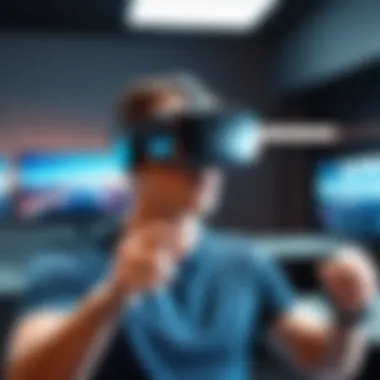
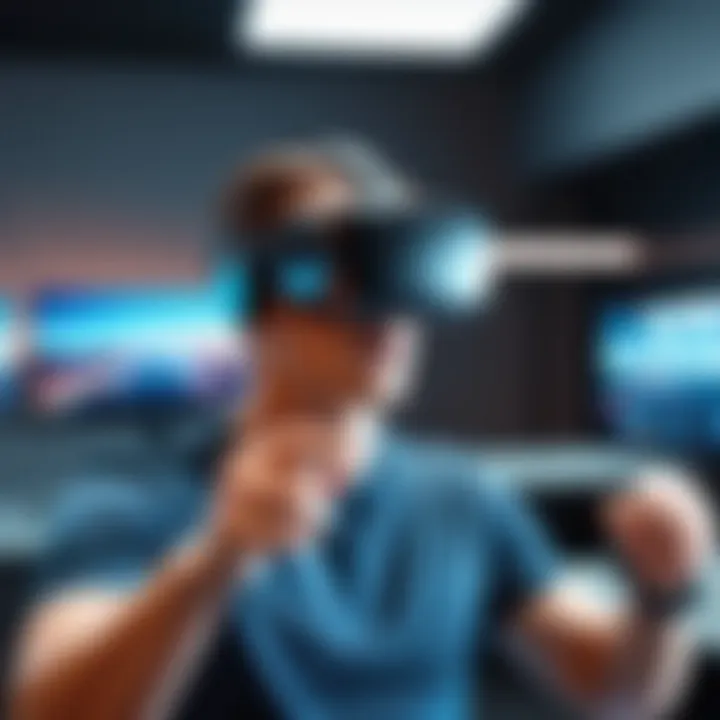
Virtual reality is rapidly evolving. It influences many aspects of modern life. Exploring the future prospects of virtual reality is crucial to understanding its long-term impact. This section delves into two specific areas: technological advancements and market expansion. These aspects highlight why virtual reality remains a focus of development and innovation.
Technological Advancements
The next few years hold great promise for technological advancements in virtual reality. Major companies are investing heavily in research and development. Improved hardware, such as the Meta Quest Pro and Sony PlayStation VR2, showcases enhanced graphics, speed, and user comfort. These iterations target both consumers and enterprises, elevating user experience.
Moreover, the integration of artificial intelligence into VR platforms is significant. AI contributes to creating more responsive virtual environments. For instance, intelligent avatars can interact with users in personalized ways, enhancing the realism of experiences. Haptic feedback technology is also progressing. Devices can simulate touch and movement, bridging the gap between the physical and virtual worlds.
In addition, cloud computing is a game changer. It allows for more complex environments that do not depend on local processing power. This leads to wider accessibility through devices like smartphones and tablets, which broadens the potential user base significantly.
Market Expansion and Adoption
Market expansion for virtual reality technology is evident across various sectors. Industries such as education, healthcare, and entertainment are quickly adopting VR solutions.
- Education: Schools and universities are integrating VR into curriculums. This brings immersive learning experiences to students, enhancing engagement.
- Healthcare: Medical professionals use VR for training and therapeutic applications. This results in better patient outcomes and improved procedural skills.
- Entertainment: The gaming industry sees continued growth due to increased interest in VR gaming. Titles like Half-Life: Alyx have set a new standard, exciting gamers to invest in VR technology.
A report from PwC predicts that by 2030, the global VR market could surpass $1 trillion. As more companies produce affordable hardware and software solutions, the adoption rate continues to increase. Consumer interest is likely to spur further innovation, making virtual reality more accessible to a wider audience.
"The future of virtual reality is not just in entertainment; it’s reshaping how we learn, train, and interact in various environments."
In summary, the future of virtual reality shows great promise through ongoing technological advancements and broader market adoption. This creates exciting opportunities for professionals across industries and invites new ways to engage with digital content.
Challenges and Limitations of VR
Virtual reality (VR) presents a range of exciting opportunities. However, it is not without its challenges and limitations, which are crucial to discuss in this article. Addressing these issues helps us understand the overall landscape of VR technology. Without acknowledging the barriers, we risk overselling its applications and underestimating its shortcomings.
Technological Barriers
One of the primary challenges hindering the widespread adoption of VR is technological barriers. This includes high costs associated with VR headsets and equipment, which can limit accessibility for many users. For example, systems like the Oculus Rift or HTC Vive require investment not only in hardware but also powerful computers capable of running VR applications smoothly.
The complexity of setup can also be a barrier. Users often encounter technical issues during installation, which can deter new adopters. Moreover, incompatibility with existing systems and software can complicate integration into current workflows. There's a learning curve too; users must acclimatize to navigating virtual environments, which may demanding additional training.
Another aspect is the rapid pace of technological advancement. Equipment can become outdated quickly, leading to further investment. VR developers must continuously innovate to keep up with user expectations, which can pose a challenge, especially for smaller companies.
"VR technology needs to evolve rapidly; otherwise, it risks obsolescence as users seek more advanced experiences."
Health Concerns and Discomfort
Health concerns also present a critical limitation for VR technology. One of the most frequently reported issues among users is motion sickness. Immersive environments can create a disconnect between visual and physical experiences, causing discomfort. Symptoms may vary but often include nausea, dizziness, or headaches. This can limit the time spent in VR, affecting its utility in prolonged applications such as training or education.
Another concern revolves around eye strain. Users often wear headsets for extended periods, which can lead to fatigue or discomfort. The narrow field of view in many VR headsets can also affect visual comfort, contributing to physical discomfort.
Furthermore, the interaction with virtual environments might promote poor posture. Users have reported neck and back pain due to improper positioning while engaged in VR activities. Ergonomics becomes a significant factor, influencing how long they can use the system comfortably.
In summary, while virtual reality has a bright potential, it is essential to navigate the challenges and limitations that come with its usage. This balanced view allows both developers and users to make informed decisions about the technology.
Culmination
In this concluding section, we will outline the significance of virtual reality (VR) explored throughout this article. Understanding VR's multifaceted benefits is essential as it shows how the technology transcends mere entertainment. Instead, it holds substantial promise across various sectors like education, healthcare, and corporate training.
Summarizing the Benefits
The exploration of VR highlights several key advantages:
- Enhanced Engagement: VR offers immersive experiences that capture attention efficiently. This is vital for educational purposes where student involvement can greatly influence retention.
- Improved Outcomes: Various studies indicate that VR can positively affect learning and patient care, leading to better results in both fields.
- Realistic Training Environments: Professionals in fields such as healthcare can benefit from realistic training scenarios. This practical experience is invaluable, often exceeding what traditional methods can provide.
"Virtual reality is more than a tool; it is an expansive medium that fosters innovation across the board."
In essence, these benefits collectively contribute to a richer interaction with technology and foster a learning approach that capitalizes on practical experiences.
Future Directions for Research
Looking ahead, further investigations into VR are crucial to optimize its application across different domains. Key areas for future research include:
- Health and Safety Studies: More comprehensive studies addressing health concerns associated with VR usage are necessary to ensure user safety.
- Accessibility Improvements: Research focusing on making VR more inclusive could enable users from diverse backgrounds and with different abilities to fully embrace these technologies.
- Long-term Impact Analysis: Understanding the long-term effects of VR engagement on users is critical. This includes aspects like cognitive development, emotional health, and social interaction.
Encouraging interdisciplinary studies will be valuable. Experts from sectors like psychology, education, and technology should collaborate to offer deeper insights. This will ensure that the implementation of VR leads to sustainable and beneficial outcomes in the forseeable future.



